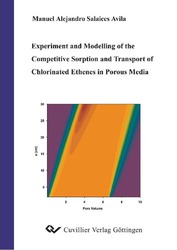| Departments | |
|---|---|
| Book Series (96) |
1379
|
| Nachhaltigkeit |
3
|
| Gesundheitswesen |
1
|
| Humanities |
2367
|
| Natural Sciences |
5407
|
| Mathematics | 229 |
| Informatics | 319 |
| Physics | 980 |
| Chemistry | 1364 |
| Geosciences | 131 |
| Human medicine | 243 |
| Stomatology | 10 |
| Veterinary medicine | 108 |
| Pharmacy | 147 |
| Biology | 835 |
| Biochemistry, molecular biology, gene technology | 121 |
| Biophysics | 25 |
| Domestic and nutritional science | 45 |
| Agricultural science | 1004 |
| Forest science | 201 |
| Horticultural science | 20 |
| Environmental research, ecology and landscape conservation | 148 |
| Engineering |
1793
|
| Common |
98
|
|
Leitlinien Unfallchirurgie
5. Auflage bestellen |
|
Advanced Search
Experiment and Modelling of the Competitive Sorption and Transport of Chorinated Ethenes in Porous Media (English shop)
Manuel Alejandro Salaices Avila (Author)Preview
Table of Contents, Datei (56 KB)
Extract, Datei (56 KB)
The transport of multiple solutes in natural aquifers may be influenced by the hydrologic, geologic and environmental conditions. A competitive sorption may take place, increasing the complexity of the mechanisms that could define the transport and fate of the substances. An understanding of the competitive sorption and the multiple factors that could influence it were investigated.
Column experiments were conducted to investigate the transport and the competitive sorption of trichloroethene (TCE) and 1,2-cis-dichloroethene (cis-DCE) in porous media. These compounds were selected as model contaminants, due to their widespread study, and because they are found in many aquifer sites like in Lauf a.d. Pegnitz (Germany). The column experiments were designed to simulate real conditions as in the aquifer.
The liquid samples from the effluent of the column were analysed with a method developed in this work for the analysis of water samples containing chlorinated ethenes based on the Headspace-Solid-Phase Micro Extraction, HS-SPME, technique followed by Gas Chromatography, GC-FID. The optimal conditions for the sampling and analysis were established. The analytical method proved to be fast (within minutes) and it permitted to acquire reliable and highly reproducible breakthrough data in a relatively short period of time.
The experimental breakthrough curve data was modelled with a numerical routine developed for this thesis, called NEMMCS and written in Fortran. A robust and stable method was selected and further developed to solve the advection-dispersion transport equation based on the Moving Concentration Slope technique, and adapted in this thesis for the transport of multiple solutes. The program is capable to solve the transport equation under equilibrium conditions or under kinetically controlled conditions. The two site kinetic model was implemented with the reversible non-linear kinetic model, the reversible bilinear model, and the pore diffusion model. The Freundlich equilibrium isotherm and the Langmuir equilibrium isotherm were used, either as single solute isotherm or the extended competitive models.
A competitive sorption of cis-DCE and TCE was observed during the transport of both solutes through silica gel in column experiments. The competitive sorption was manifested in the breakthrough curve as an increase above the input concentration of cis-DCE, the solute with less sorption affinity, and decreasing later to its equilibrium concentration. This phenomenon is commonly known as an overshoot. The overshoot was investigated at different concentrations of cis-DCE at a fixed concentration of TCE. From the breakthrough curve experimental data, the equilibrium isotherms were determined with the Freundlich isotherm and Langmuir isotherm. The parameters were first obtained from single solute experiments, and later tested with the extended competitive models.
The experimental breakthrough curve data was modelled with the program NEMMCS considering the pore diffusion model and the local equilibrium assumption model. The modelled breakthrough curves were in good agreement with the experimental breakthrough curve data. The effective diffusion coefficient was optimised with an inverse modelling technique with the software PEST. The adsorption/desorption cycle was examined in the hodograph plane.
| ISBN-13 (Printausgabe) | 3865376061 |
| ISBN-13 (Hard Copy) | 9783865376060 |
| ISBN-13 (eBook) | 9783736916067 |
| Language | English |
| Page Number | 264 |
| Edition | 1 Aufl. |
| Volume | 0 |
| Publication Place | Göttingen |
| Place of Dissertation | Erlangen |
| Publication Date | 2005-10-05 |
| General Categorization | Dissertation |
| Departments |
Chemistry
Engineering |








